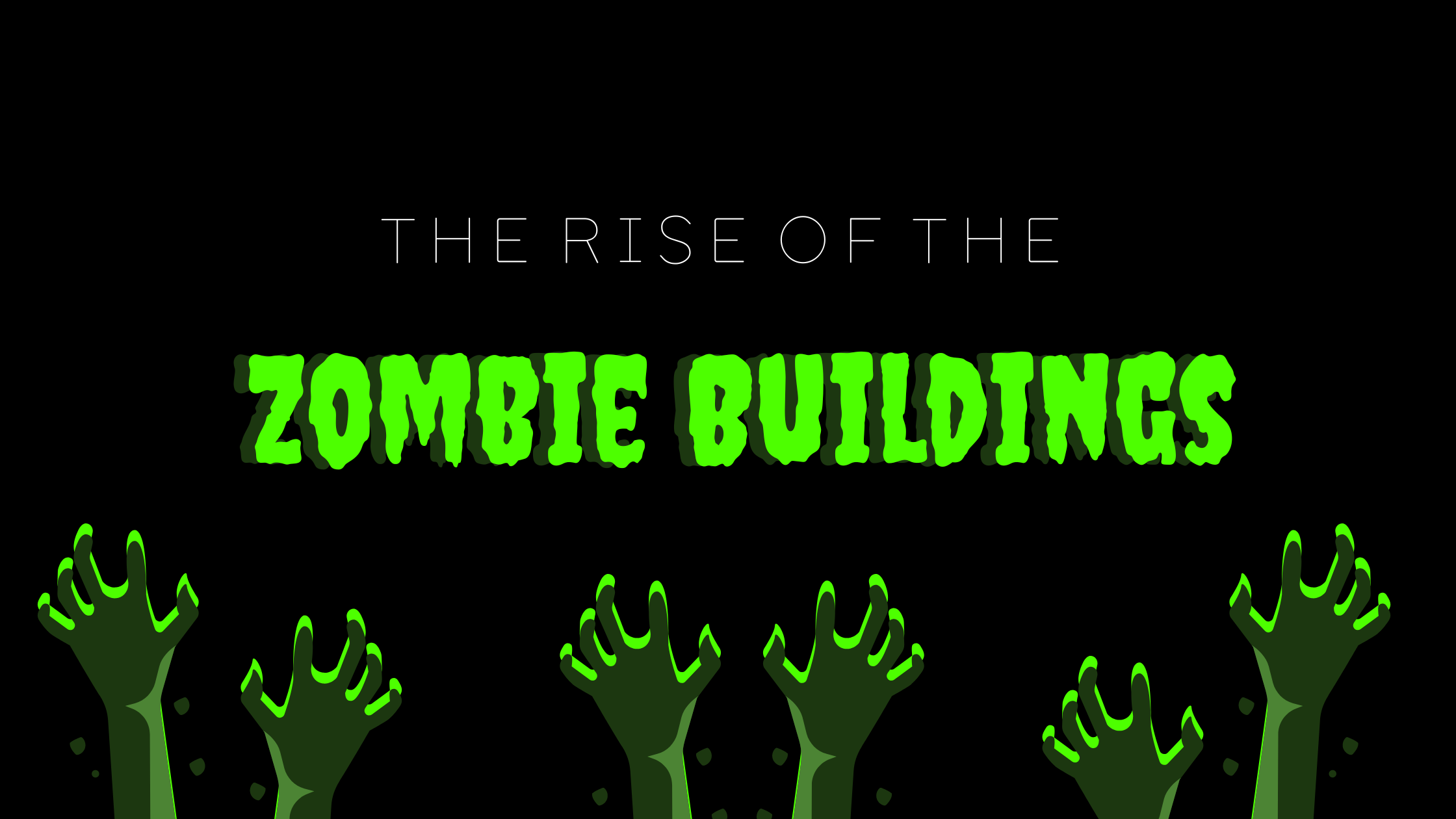
They’re not out for your brains, but the empty office buildings have been termed zombie buildings – as they sit vacant, wasting away. These “zombies” are, largely, a result of the pandemic and the boom of work-from-home that came with it. Even now, three years on, hybrid work has become more of the norm, and these buildings remain empty. Experts fear these these buildings represent a debt timebomb and a potential destruction of the commercial real estate market as we know it, as commercial landlords walk away from these zombies.
WHAT REQUIREMENTS MUST A BUILDING MEET TO BE A ZOMBIE?
A building is a “zombie” when its vacancy rates result in 50% or less utilization. A research study done by the Boston Consulting Group found that, on average, vacancy rates have risen 5% and utilization has dropped by 28%.
WHY ARE OFFICE BUILDINGS BECOMING ZOMBIES?
A big reason for these empty buildings is the covid-19 pandemic, pushing office workers to hybrid or work-from-home models. It also lead to more short-term lease options; as a result, 60% of office leases are set to expire in the next three years.
ARE THERE ANY OTHER IMPLICATIONS TO A ZOMBIE BUILDING THAN LANDLORDS HAVING A POOR INVESTMENT?
Although it may seem that the low utilization would be just an issue for the owner(s) – it’s not the case. As zombie buildings have been noted for a time now, experts are starting to see a cycle emerging.
Offices are not being rented –> less money spent at surrounding businesses –> less rent revenue for those building owners –> less money for building improvements –> decreases property values & resources –> other businesses that cater to office workers must relocate –> more vacancies –> cities suffer
This is not a problem for just one group of people or people of a certain tax bracket. Therefore, solutions require the work of owners, city leaders, lenders, and others. It requires collaboration on options for improvements and on how to break the cycle.
In some cases, there are fears that building owners may owe more than the building is worth, leading to defaults. In February of this year, two office skyscrapers were defaulted on, with 784 million dollars in loans. Faced with loans due and decreasing profit, some investors are electing to give the keys back to the lenders.
WHERE IS THIS A PROBLEM?
These buildings are a problem in most major office markets, but typically in markets that have a higher concentration of office buildings than residential and retail; as well as areas whose prevalent industries are able to accommodate work-from-home structures, like tech.
Some examples of cities hit hard by zombie buildings are:
- New York: 40-50% relative decline from pre-pandemic levels
- San Francisco: 50 – 60% relative decline from pre-pandemic levels
- Washington DC: 40-50% relative decline from pre-pandemic levels
- Chicago: 35-45% relative decline from pre-pandemic levels
- Los Angeles: 45-55% relative decline from pre-pandemic levels
Per Investopedia, within the ten largest US markets, more than 50% of office space sat unoccupied in June 2023. This could spell future trouble as leases come up, experts are afraid that the tenants won’t renew & as delinquency levels rise.
There are also certain buildings more at-risk of becoming zombies. These buildings are specifically older, cubicle office buildings that lack modern amenities or are occupied by industries that do not have to work on site.
HOW TO REDUCE/ELIMINATE ZOMBIE BUILDINGS?
Property managers will have to consider their commercial portfolio and sections of different buildings to determine if they should:
- Remain in commercial leasing
- Renovate to update or change the use of space
- Repurpose the space as it is no longer economically viable as an office
- Redevelop with assistance from cities
- Relinquish to lenders
Many are asking for these zombie commercial buildings to transform into residential units. The National Bureau of Economic Research found that more than 2,000 office buildings in America could be converted into apartments; yielding between 170,000 & 400,000 new apartment units. As the United States is in a housing crisis, these new units could be good to help remedy the situation – especially as the three worst areas for zombie buildings are also ones that have high housing costs and a need for more housing.
This conversion would also be a more eco-friendly and potentially more economically beneficial option – as it can be cheaper to retrofit buildings and if they were done in a “green” way it could also open up the opportunity for grants.
Some other ideas that have been posed for these office buildings include: hotel or hostel conversions, pop-up shops, educational institutions, green spaces or urban farms, art/cultural centers or tech/innovation hubs, amongst others.
OVERALL
Although it may seem that these zombie buildings only affect the corporations that own or manage them, experts believe that the ramifications will be far reaching if no resolution occurs. They believe that over the next three years the number of unoccupied buildings will continue to increase; therefore, it is vital that cities, lenders, and owners get ahead and begin brain-storming ideas to reduce their economic hit and keep the economies of these cities thriving.

